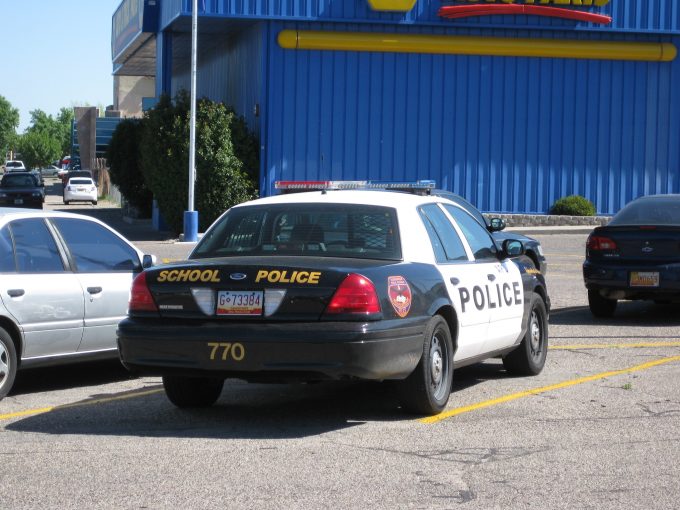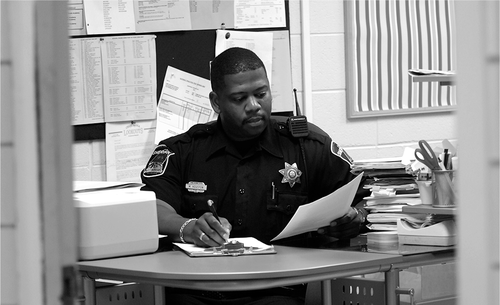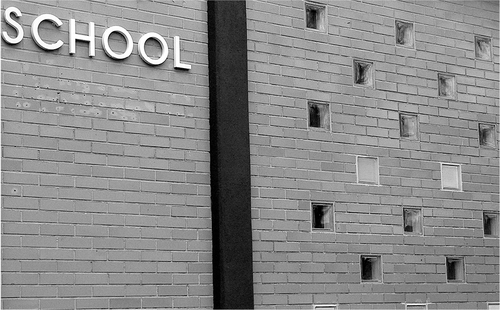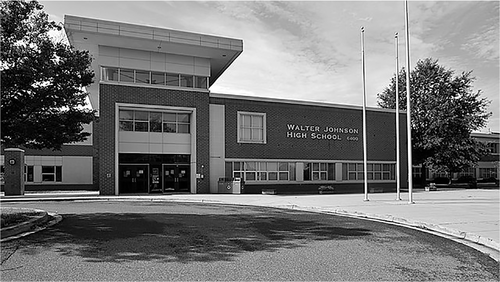Reconsidering Police in Schools

This article originally appeared in a report by The Brookings Institution and the American Enterprise Institute. It was supported with the generous support from the Ewing Marion Kauffman Foundation. Contexts Magazine appreciates the ability to further highlight this work.
In this article on School Police Officers (SPOs), we showcase the link between SPOs and exacerbated racial disparities in justice involvement and youth being driven deeper into criminal justice systems. SPOs have been linked with increased arrests for non-criminal, youthful behavior, fueling the school-to-prison pipeline. It is important to note that the presence of SPOs is notably higher in schools with higher percentages of Black or Latino youth. Singling out the concerning and ever-widening reach of the justice system, SPOs are frequently given authority to intervene when non-criminal school rules are broken. By engaging mostly in law enforcement tactics, such as arrests, rather than education and mentorship programs that can act as preventative measures to rule-breaking at school, SPO presence often results in overall harsher punishments and increased arrests for youth non-criminal behavior.
These policing practices “disproportionately expose children of color to the justice system at a young age [and] are correlated with a higher likelihood of incarceration as an adult”. Given the long term consequences associated with a single arrest—increased likelihood of dropping out and long-term consequences in obtaining adequate employment—we present policy recommendations to help rethink investments toward the types of approaches that are more likely to make schools safe and away from SPO involvement. These include using counselors, social workers and teachers, and alternative and restorative justice practices to address problematic behavior in schools.
A History of School Policing
The presence of law enforcement in schools has been a controversial issue for decades. High profile school shootings combined with concerns about rising rates of violence among youth during the 1990s were a catalyst for federal funding for more police in schools, frequently referred to as “School Resource Officers” or “School Police Officers” (SPOs). Supporters of SPOs believe that the presence of police in school serves as a deterrent to serious crime, while also allowing for a more rapid response in the event of any potentially criminal behavior occurring on campus. The expansion of SPOs in schools goes back to 1999 in response to the school shooting at Columbine High School. The federal Community Oriented Policing Services in Schools Program (COPS) distributed $68 million to jurisdictions in 2000, resulting in the hiring of 599 SPOs in 289 communities across the country. The federal government has since decreased its resource allocation to SPO programs, but state and local governments have continued to support the hiring of more officers. This article will outline the negative consequences of these investments and provide short-, medium-, and long-term strategies to reimagine how this country protects our children and keeps our schools safe.
SPOs and the School-to-Prison Pipeline
The expansion of SPOs occurred during an era of nationwide declines in juvenile crime and arrests. The 1990s were characterized by an increase in violent crime, peaking at 413 instances of violent crime per 100,000 youth. This increasing crime rate culminated in the notorious “superpredator” label applied to a generation of young people, mostly youth of color, who were seen as increasingly unmoored from society, dispossessed of the American Dream, violent, predatory, and an ominous threat to public safety. This was the era during which zero-tolerance policies, including infractions in school for behavior that school administrators historically addressed, drove an increase in youth arrests and ushered in the “school-to-prison” pipeline. These zero-tolerance policies disproportionately impacted youth of color by placing them in the justice system. Black students comprised 36 percent of arrests in the 2015–2016 school year, despite accounting for only 15 percent of the student body.
A few short years later, the 21st century ushered in historic and sustained declines in juvenile crime that belied the warnings of superpredators and gave birth to a movement demanding the downsizing of the juvenile justice system. Reforms were catalyzed by an evolving body of research that highlighted the futility of youth incarceration and a call for more investment in community-based reforms that recognize children’s unique amenability to transform their lives with age-appropriate supportsand services.
This burgeoning movement, comprised of advocates, practitioners, justice-involved youth and their families, and funders, has galvanized tremendous change in the American juvenile justice system in the short quarter-century since elected officials warned about the need for prisons for irredeemable, violent youth. The unifying thread of these reforms is an effort to reduce the justice system’s role and improve non-justice interventions that preserve children’s connections to school, family, and pro-social peers. SPOs represent an increasingly incongruous strategy to the evolving justice policies and removing police from schools has been a long-term goal of many advocates. The tragic cases of police violence and the nationwide demands for reform during the summer of 2020 amplified the SPO issue as calls to “defund the police” included an early focus on removing police from schools.
Rates of youth violence were plummeting independent of law enforcement interventions. Additionally, SPOs have been linked with exacerbating racial disparities in justice involvement and youth being driven deeper into the juvenile and adult criminal justice systems. Rather than preventing crime, SPOs have been linked with increased arrests for noncriminal, youthful behavior, fueling the school-to-prison pipeline.
Reimagining public safety in schools requires a rethinking of how resources are allocated moving forward. This includes what services and supports are available to youth, as well as staffing decisions and where jurisdictions prioritize their investments. The dominant law enforcement paradigm is losing support and communities are demanding reform. Some immediate steps can be taken to address many of the concerns outlined in this article, but meaningful and sustainable change will take time.
Short-Term Reforms
- Put the “Resource” in SROs
- School Leadership must Strictly Limit their Roles and Responsibilities
Medium-Term Reforms
- Eliminate Funding for Police in Schools
- Remove Police from Schools and Invest in Supports and Services Proven to Contribute to Safety
Long-Term Reforms
- Break the School-to-Prison Pipeline
Short-Term Reforms
Put the “Resource” in School Resource Officers
While typically referred to as School Resource Officers, School Police Officers is a more accurate way to describe law enforcement officers detailed to schools based on historical practices. These individuals are trained police officers that function like an arm of local law enforcement rather than counselors or other support services that provide essential resources to staff and students. The “Resource” in School Resource Officers is often a misnomer.

The deployment of SPOs is typically established by a partnership agreement among local leaders, such as the Board of Education and the local law enforcement agency. SPOs are, by definition, career sworn officers who typically receive the same academy training for street patrol as other police officers but are stationed in a school building. Since they are affiliated with the local police department, there is no national database tracking SPOs in America. However, according to the National Association of School Resource Officers, estimates range between 14,000 and 20,000 SPOs in America’s schools at any given time. Estimates suggest that close to $1 billion has been invested from state and local budgets since 1999 to continue funding SPOs in schools.
Rates of juvenile arrest and school-based victimization have been steadily falling, similar to the declines in national crime rates in recent decades. As of 2017, the National Center for Education Statistics reports that victimization, theft, and violent crime are at a multi-decade low. In the 2015–2016 school year, there were 18 homicides at schools, accounting for 1.2 percent of all youth homicides.
Because serious crime occurs so rarely on school campuses, SPOs spend most of their time investigating minor incidents. This is core to their job, not merely a function of using whatever free time they have to investigate low-level offenses. Some SPOs pursue these minor investigations vigorously and often disproportionate to the underlying conduct. Time spent investigating minor offenses creates an environment where “schools subject students to strict scrutiny” for behavior that would not reach this threshold had it occurred outside of campus. One study of schools in urban jurisdictions found “an estimated quarter of new charges filed against youth were school-related and one out of every six charges in school occurred in cases where no crime was committed, but an SPO was present.”
This example of “mission creep” among SPOs is a common criticism of police in schools. While they are ostensibly in schools to enforce the criminal code, such as drug and weapons offenses, many have additional authority to intervene when noncriminal, school rules such as violating prohibitions on cell phones are broken. This represents a concerning widening of the role of the justice system.

It does not have to be this way. Interviews with SPOs revealed that those who developed relationships with students were less likely to resort to the justice system to respond to less serious behavior. At the same time, SPOs who behaved like more conventional police officers were more likely to rely on the justice system. Moreover, a case study where a county developed system changes and established a detailed set of rules for SPO conduct found that court referrals reduced by 67 percent, graduation rates increased to 80 percent, felony referral rates decreased by 31 percent, school detention decreased by 86 percent, court referrals of youth of color decreased by 43 percent, and there was a 73 percent reduction in serious weapons on campus. These findings underscore the need for staff training before any law enforcement enters a school building and strengthen the argument that schools need resources, not the police, to handle the vast majority of issues that occur on campus.
School Leadership Must Strictly Limit Their Roles and Responsibilities
Beyond getting involved in school disciplinary issues, the presence of SPOs is also linked to an increase in the use of arrests for both nonviolent and violent criminal behavior. In cases of serious violent crime, non-school based police will respond regardless of an SPO presence. However, schools with SPOs have a disproportionate rate of arrests for nonviolent behavior. A longitudinal survey of 480 schools for three years found that schools with SPOs reported more crime than those without SPOs. Schools with SPOs engaging in education and mentorship programs reported fewer crimes than schools with SPOs engaging only in law enforcement. Schools with SPOs recorded a 27 percent higher rate of property crimes and a 57 percent higher rate of serious/weapon/drug crimes than non-SPO schools, when controlling for pre-existing differences. A review of the research between schools with SPOs and without SPOs concluded “[t]he best designed and most representative study of SPO influence to date suggest that increases in the SPO workforce in schools is related to increases in reporting of crime, higher likelihood or harsher punishments for students, higher rates of weapon and drug crimes, and more reporting of non-serious violent crimes, compared to rates in schools without SPOs.” While we lack data on how much more harshly youth are treated when referred to the criminal justice system, it is important to note that merely being referred to the criminal justice system is in itself a harsher punishment. In the past, many of these situations were handled in the principal’s office rather than the police precinct.
School leadership should enter a transparent memorandum of understanding between the SPOs, teachers, administrators, parents, and students. Such an agreement should provide necessary detail of the scope of SPOs and allow local stakeholders to weigh in on the extent of their work. Research shows that this upfront agreement can result in fewer court referrals, fewer violent offenses, and higher graduation rates. These agreements should regulate law enforcement’s role in discipline and education while the locality works to supplement their safety strategy with non-justice actors.
Medium-Term Reforms
Eliminate Funding for Police in Schools
In addition to local school leadership actions, the federal government should terminate all funding for police in schools. On average, the federal COPS Office Hiring Program distributed $125,000 per new hire for a three-year grant cycle. According to the funding regulation, it can include 75 percent of the entry-level salary and fringe benefits over the grant duration. The Economic Research Institute reports that the average SPO salary can cost a locality $70,000. This is deeply unfortunate as many schools lack funding for essential supports such as counselors, nurses, and school psychologists. For example, a report by the American Civil Liberties Union found that nearly two million students attend a school with an SPO but no counselor. That same report revealed that six million students attend a school with an SPO and no school psychologist. Finally, one in four students is in a school with an SPO but no counselor, nurse, school psychologist, or social worker. When people call for divestment from police and investment in other proven solutions that work, this is precisely the type of funding imbalance that fuels those demands. That investment in SPOs would be much better targeted toward qualified school personnel proven to be better suited to deal with problematic student behavior, rather than for a law enforcement officer assigned to a school who does not have the education or training to provide quality counseling or other social work type supports.
Remove Police From Schools And Invest In Supports And Services Proven To Contribute To Safety
State and local leaders should also remove police from schools and invest in much needed supports and services, such as counselors, psychologists, training for teachers and administrators, and health care. This is not an easy process. It involves the consent of school leadership, the Board of Education, local leadership such as the mayor or county executive, and parents. This process can be difficult, emotional, and time consuming. For example, Montgomery County, Maryland engaged in a multiyear debate complete with research from an outside consultant before finally deciding to remove police from schools in 2021 for the first time in nearly two decades.
Despite these challenges, some communities have already begun to shift funds away from school-based law enforcement, with the potential for substantial reinvestment opportunities. Policymakers should be informed by the research and recent experiences to redirect resources from the deployment of SPOs and instead invest in communities and the types of approaches that are more likely to make schools safe, such as well-trained counselors, social workers and teachers, and alternative and restorative justice practices to address problematic behavior.
Portland, Maine, which just recently voted to eliminate SPOs from the school district, said it would reinvest the $150,000 budget savings into de-escalation training for school personnel. Moving on from SPOs can alter the foundation of school safety, as seen in Oakland. In 2019, the Black Organizing Project recommended eliminating the SPO program and its $4 million annual budget. They envisioned a new force of unarmed peacekeepers that would be part of a school’s special education or behavioral health department. The new team would undergo training in de-escalation, trauma-informed practices, and eliminating racial bias. In June 2020, the city council voted to officially eliminate the SPO program and invest in a model adopting some of the Project’s core initiatives.
Long-Term Reforms
Break the School-to-Prison Pipeline
Studies show that the presence of SPOs results in harsher punishments for minor offenses than school administrators would have otherwise administered. Students in these schools are more likely to be arrested and referred to the criminal justice system. Another study asked both SPOs and school administrators for their views on discipline. The study reported that when the philosophies of SPOs and administrators were compared within the school, “83 percent of school administrators were more prevention-oriented than the SPOs stationed in their schools.” There is a suggestion here that SPOs are more likely to seek disciplinary responses than prevention, resulting in overall harsher punishments and increased arrests. These policing practices, which disproportionately expose children of color to the justice system at a young age, are correlated with a higher likelihood of incarceration as an adult. This is commonly referred to as the school-to-prison pipeline.
Allowing police officers to handle minor infractions in schools needlessly marks a student’s first contact with the criminal justice system, potentially setting them up for a lifetime of collateral consequences. Nationwide, there were 44,370 school-based arrests during the 2013–14 school year, which increased to 51,780 arrests in the 2015–16 school year. Seven percent of all youth arrests occurred at schools, and many of these incidents could have effectively been handled by school personnel rather than SPOs. A Washington Post review found that many students were charged with crimes for minor offenses, such as throwing a paper airplane, kicking a trash can, wearing sagging pants, and throwing a carrot at a teacher.

These zero-tolerance policies are disproportionately impacting youth of color by placing them in the justice system. Black students comprised 36 percent of arrests in the 2015–2016 school year, despite accounting for only 15 percent of the student body. Meanwhile, 33 percent of those arrested were white, despite representing 50 percent of students. In Washington D.C., Black girls are nearly six times more likely to be suspended from school than white girls. This criminalization in schools drives arrest rates, with the per capita arrest rate for Black girls more than doubling from 2007 to 2015 and Black girls arrested at a rate over 30 times that of white youth. The study attributes part of this discrepancy to increased referrals to the juvenile justice system for typical adolescent behavior and minor misbehaviors that should be addressed within the school.
While many of these school arrests may not ultimately end up processed in court, they can lead to long-term consequences. A single arrest can impact a student’s achievements and leads to a 25 percent increase in the likelihood of dropping out of school. Lack of educational attainment can also have dire consequences in obtaining adequate employment. All of these are components of the school-to-prison pipeline.
Some argue that this type of aggressive enforcement of disciplinary violations of school rules creates a “zero tolerance” environment that helps deter more serious crimes. This is the basic underlying principle of “stop and frisk” and “broken windows policing,” by which aggressive enforcement of minor “quality of life” issues contributes to a culture of widespread enforcement that prevents more serious crime. However, these practices, which come at the expense of fundamental civil liberties, have not been shown to make communities safer, target people of color, and many jurisdictions have been forced to curtail zero tolerance enforcement efforts in response to citizen complaints and legal action.

Jurisdictions must take intentional steps to break the school-to-prison pipeline and reduce the number of youth entering the justice system at all. In addition to phasing out and ultimately removing school police officers, actions include:
- Implementing strategies to create alternatives to suspensions and expulsions
- Creating healthy school cultures based on age-appropriate, incentive-based behavioral approaches
- Integrating school and community-based restorative justice approaches instead of punitive disciplinary practices
- Having adequate numbers of well-trained, school-based counselors and mental health staff
- Investing in positive community-based supports for young people to be productively occupied during non-school hours
- Positively engaging families of students
Recommendations for Future Research
Reimagining how we can make schools safer learning environments for all children requires informed decisions about how to allocate resources most effectively. This is of particular concern when considering what services and supports available to youth contribute to safe schools. There is an urgent need for additional research to identify promising practices and assess non-punitive approaches that support students while keeping them safe. As jurisdictions decide to remove SPOs from school and replace them with counsellors and other support services, it is critical to study the impact of these changes and compare public safety and other outcomes before and after the change. Because so many schools were empty last year due to the COVID19 pandemic, this year will be the first meaningful opportunity to study the impact of any reforms.
In addition, other pressing questions include measuring the impact on school safety of approaches that do not rely on school police officers, including strategies to reduce suspension and expulsions, school-based restorative justice and alternative dispute resolution programs, training of school staff to address school safety issues and create a safe educational climate, and the presence of well-trained and qualified counselors, mental health professionals, and non-law enforcement school-based safety staff.
Conclusion
The presence of law enforcement in American schools during an era of rapidly declining juvenile crime diverts precious resources from prevention and support services, increases the likelihood of deeper engagement in the justice system, and exacerbates existing racial disparities. While packaged as a form of community policing, the reality is that law enforcement in school results in more punitive responses versus promoting a safe learning environment by building trust and relationships. There will continue to be a need for police to respond to crime in schools, but that can be done in the same manner police respond to crime in communities. The presence of law enforcement officers in school as a preventative measure too often runs the risk of criminal responses to delinquent behavior that administrators should handle. Removing police from schools and investing the savings in counselors, psychologists, and proven support services has the potential to prevent crime without the attendant negative consequences of criminal justice system involvement.
Recommended Readings
- N.A., Reforming Juvenile Justice: A Developmental Approach (Washington, DC: The National Academies of Science, Engineering and Medicine, Washington, 2013). Google Scholar
- Gottfredson, Denise C. , et al., “Effects of school resource officers on school crime and responses to school crime,” Criminology and Public Policy 19, (2020): 905–940. Google Scholar | Crossref
- Dignity in Schools Counselors not Cops: Ending the Regular Presence of Law Enforcement in Schools (Dignity in Schools, 2016). Google Scholar
Marc Schindler is Executive Director of the Justice Policy Institute (JPI), a national non-profit research and policy organization dedicated to reducing the use of incarceration in the juvenile and criminal justice systems. Prior to joining JPI, Marc was a partner with Venture Philanthropy Partners (VPP), where he led VPP’s Social Innovation Fund youthCONNECT initiative. Marc previously served as a Staff Attorney with the Youth Law Center (YLC), a national public interest civil rights law firm dedicated to protecting the rights of young people in juvenile justice and child welfare systems nationwide, and as a public defender representing children in Baltimore’s juvenile court. Marc is a recognized expert in the field, providing commentary in the national media, including in The New York Times and The Washington Post and on CNN and NPR, and is also the author of numerous articles and book chapters.
Ryan King is the Director of Research & Policy at the Justice Policy Institute. King works on sentencing and corrections issues with a focus on reducing correctional control. His work has focused on high-quality empirical research on the impact of sentencing and corrections policies at the state and federal level and works with policymakers, practitioners, and community advocates to identify strategies that assist in pursuing a fair, effective, and rational criminal justice system. King’s research has appeared in Criminology & Public Policy and the Federal Sentencing Reporter. In addition, his work has been featured in the Associated Press, New York Times, Washington Post, and USA Today, and he has appeared on local and national radio programs to discuss sentencing and corrections issues.
